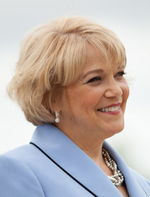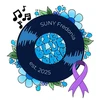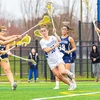 Dr. Virginia S. Horvath began as SUNY Fredonia’s 13th President on July 1. At May’s Commencement, President Hefner presented Dr. Horvath with a symbolic key, representing one of his favorite statistics: the 5,406 doors on Fredonia’s campus. “I hope it will help you keep every one of those doors open for future generations,” he said. |
In 2005, Virginia Horvath made one of the toughest decisions of her life.
She had a chance to return to her native Western New York and become Vice President for Academic Affairs – the second-highest ranking position – at a 180-year-old liberal arts college which had seen considerable growth and revitalization recently. It would also bring her closer to her father who, on the heels of her mother’s passing, was dealing with some health issues of his own.
However, it would also take her away from her husband, Brooke, their four grown daughters, and the life they had built together at Kent State University, where she had lived and worked for more than 20 years.
It was a difficult choice, but something happened during the interview process at that college – a little place called SUNY Fredonia – that made her realize logging all those weekend visitation miles to Ohio and back would be well worth it.
“In every session of my campus interview here, people would give me details about the campus and programs,” she recalls, “but what really lit up their faces was when they talked about students. I saw it in everyone – the staff, faculty, administrators. That’s what charges everyone here and what drew me to this place.”
The decision paid off, as today Dr. Virginia S. Horvath finds herself as SUNY Fredonia’s 13th President, completing a dream of hers that began more than 20 years ago. For many years, Ginny, as she likes to be known, seemed very happy following the traditional path of a professor. Having earned her undergraduate degree at the University of Buffalo by age 20, the SUNY alumna moved quickly to continue her education by enrolling in master’s and then doctoral programs at Kent State. She liked the university very much and, when presented with an opportunity to stay and join the English faculty in 1985, she readily agreed.
However, the circumstances of her appointment exposed her to more administrative responsibilities than a typical faculty member sees. She joined the faculty of Kent State East Liverpool, a small (400 students at the time) campus in an eight-campus system which currently enrolls more than 40,000 students. The experience had a profound impact on her, opening her eyes to the differences she could make on many lives from a leadership role.
“I was one of just nine full-time faculty,” she says of the open admission East Liverpool campus. “Most of the students were women. The average age was 28. Many thought they’d never go to college. We saw lives change in just four semesters – not just their lives, but the lives of whole families.”
The experience invigorated Dr. Horvath, inspiring her to go far above her daily faculty requirements.
“Teaching there wasn’t just a paycheck or a job or something I would do so I could have my summers free for research,” she explains. “It was very humbling for me to see that these students – with all of their family pressures – still made time for education. Almost all were the first in their families to earn a degree.”
In many ways, she could relate to her students. She had also been a first-generation college graduate. She grew up in a large family in what she describes as a “crowded, multigenerational home where there was plenty of love but limited resources.” She and her six siblings were expected to work hard, seek life-changing opportunities, and – somehow – go to college.
“My parents did not have the opportunity to attend college, but my mother always emboldened us to venture beyond our modest beginnings,” she recalls. “Although I wanted to go away to college, I learned frugality, as I worked to pay my own way at a local university. I learned practicality too, discovering that registering for more than 20 credit hours each semester would allow me to graduate a year earlier.” The East Liverpool Campus’ limited faculty numbers required Dr. Horvath to wear many hats and, out of necessity, thrust her into an administrator’s role.
“We were on all the committees: the governance, tenure, promotion, facilities, student life, and community service,” she explains.
She learned about university planning and budgets, enrollment and recruiting, and governance. She soon found herself not just serving on committees, but often heading them up.
“As a result, people started saying to me, ‘You should be an administrator,’” she remembers. “I kept resisting, because it was important to me to progress through the academic ranks,” which she did when she was promoted to full professor in 1999.
However, the turning point she believes came a few years earlier, in 1991, when she won the Distinguished Teaching Award at Kent State, a prestigious honor given by its alumni association.
“Suddenly I had become an expert in certain people’s eyes,” she says. “I was soon on a national level in teaching and learning discussions.”
That led to an interim dean appointment and the surprising realization that she really enjoyed administrative work.
“It allowed me to bring some ideas to the university instead of just to my own students and colleagues in my field. I was able to work with faculty and discuss issues like curriculum, tenure and governance, because I shared their perspectives,” she adds.
In 2001 she was appointed Dean for Academic and Student Services at Kent State and began to focus more intently on assisting her institution in a time of great change for higher education. She completed the American Council on Education’s (ACE) Fellows Program in Washington, D.C., where she was one of 36 Fellows learning about the major issues of college administration. The program, which includes shadowing a college president for a year, engaged her in discussions of many issues at national and international levels. She visited more than 30 U.S. institutions and 12 in India, and she met with national leaders on such topics as government relations, diversity, media relations, curriculum, and the changing academy. Along the way, she realized what she wanted in the next campus she would serve.
“When I was in that program and placed at a small, residential college, I discovered I really wanted to be at a liberal arts college,” she recalls. “That surprised many of the others in that program, but I knew that’s where my heart is.”
SUNY Fredonia was the perfect fit, and she joined the campus in 2005 as Vice President for Academic Affairs. During the last seven years, she’s had ample opportunity to go elsewhere, but the proverbial grass never appeared any greener at other institutions.
“When you’re an academic vice president, you get a lot of calls from search firms,” she says. “Their consultants would say, ‘You should apply to this place or that one.’ And I would say, ‘I don’t think so.’ “They would ask me, ‘What kind of place would you like to be at?’ And as I would answer, the consultants would invariably say, ‘You’re describing your own campus.’ And they were right! I didn’t mean to, but I was.”
Since coming to Fredonia, Dr. Horvath has played a major role in many critical processes and initiatives, including the current and previous strategic plans, accreditation reviews, staffing and budget planning, curriculum, assessment processes and hiring. All of that, coupled with her unique knowledge and awareness of Fredonia’s strengths and opportunities, made the search committee and SUNY Chancellor Nancy Zimpher see that she was the clear candidate among more than 50 nationwide applicants to succeed retiring President Dennis Hefner.
“Dr. Horvath’s proven commitment to improving higher education in Western New York will serve her well in her new role as president,” Chancellor Zimpher said in recommending Dr. Horvath. “She has an impressive legacy of leadership that I am confident she will build upon at the college, and I know she will exceed the expectations of students, faculty, staff and alumni alike.”
“I believe she is a natural, logical choice to continue the momentum and positive trajectory our team has achieved,” added President Hefner. “We have worked very well together over the last seven years, and her impact upon this campus to date has been remarkable.”
The 54-year-old Horvath says she is fortunate to have learned from Dr. Hefner and other colleagues over the past seven years. She has enjoyed being a part of the recent successes and sees still greater potential for Fredonia. She outlined some of her ideas at a press conference following her appointment by the SUNY Board of Trustees in March.
“In the presidential (search) profile, there was a statement that said a goal for the next president would be ‘to bring Fredonia to a point of some distinction among the comprehensive colleges.’ I think that’s a pretty modest goal,” she said with a smile.
“I would like to see us do much more than that, and be recognized for the distinction we already have – not just in Western New York or the state, but even nationally, for the kinds of things that happen here that I think make it an ideal place to attend.”
She added that she understands the legacy Dr. Hefner has created: strong enrollments, impressive facilities, construction and renovation, fiscal responsibility and commitments to the many communities Fredonia serves.
“There are so many things that are going well here,” she said. “In part due to Dr. Hefner’s leadership and the work of members of this campus, I’m not stepping into a role where there are huge things that need to be addressed. This is not a ‘fixer upper.’”
Still, the campus’ first female president has already begun a legacy of her own. Her service to her profession and the campus is well known. She was the driving force behind the creation of the Fredonia Academic Community Engagement (FACE) Center, which connects student learning and pedagogy with opportunities to serve and impact the Western New York community.
Service has and will remain a big component of her life. This past January she and Brooke, a professor of English at Kent State – and “the more famous of the two of us,” she insists – traveled with a non-profit organization to Haiti for a three-day endeavor to deliver shoes to those in need, in an effort to combat injuries and diseases which are a greater health risk for people without shoes.
“Our travel with Soles4Souls was amazing,” she attests. “There’s something very different about supporting by writing a check and going to a remote area of an impoverished country, washing the feet of men, women, and children, and fitting them with shoes. We couldn’t speak much of their Creole language, but we connected through smile, touch, and even a soccer game with the kids at a UNICEF orphanage. It was humbling and rewarding.”
She believes strongly that a college should give significantly of its time and resources. That commitment will be actively demonstrated the day following her official investiture ceremony in September, as she leads students, faculty, staff and alumni in an Inaugural Day of Service at multiple sites throughout Western New York (see XXX for details).
“I’m especially interested in the parts of our strategic plan that talk about our relationships with different communities – not only those in our county, Western New York and the state, but globally,” she says. “We have opportunities to have Fredonia be a connection to the world and to bring the world to our campus.”
Under her leadership, SUNY Fredonia has also added several new academic programs, as well as the Office of Student Creative Activity and Research (OSCAR), and the Professional Development Center, which the faculty and staff have especially appreciated.
“In my five years at Fredonia, I’ve consistently seen Ginny be extremely encouraging to faculty, publicly through policy as well as privately in person,” said Dr. Rob Deemer, head of the School of Music’s Composition area and chair of the University Senate this coming academic year. “For example, the extent to which the Professional Development Center has become an integral part of our campus can be attributed in great part to Ginny’s enthusiastic leadership. Combine that with her support of the Office of Student Creative Activity and Research as well as her close work with our new Baccalaureate Goals, and you see how much she supports the advancement of a strong and creative academic culture.”
She also places a high importance on diversity, both among the student body and the employee base. She credits her international opportunities in Kenya as an American Field Service (AFS) student and in Japan as a visiting faculty member for helping to shape her commitment to global understanding as an important part of a liberal arts education. She is a major advocate for liberal arts education as essential learning for the 21st century and embraces many of the attributes that have led to the success of nearly two centuries of Fredonia alumni: small class sizes, quality, affordability, and challenging students in and out of the classroom to learn more than they thought possible.
She also believes in collaboration and has a knack for bringing people together. Even if they are widely apart on an issue, she patiently works with them until a compromise or solution can be reached.
“I once said to her, ‘I don’t know what happens in your office,’” says Pam Fabritius, secretary to the Vice President for Academic Affairs. “‘People come here and they’re upset, but then they come out, and they’re O.K. That’s amazing.’”
Students have picked up on that vibe as well.
“From the first time I met Dr. Horvath my freshman year, she showed me the opportunities available at Fredonia,” adds senior Meagan Allers, an Early Childhood Education major from Williamsville, N.Y. “She is so in touch with the students. She is Fredonia. She has seen the growth and been part of the tradition.”
However, Dr. Horvath sees these as compliments that are more about Fredonia than her. “What I’ve seen during my first seven years here is the creativity that people bring to their work and the fact that, no matter what people do, they are willing to work together – even in times of fiscal challenges – to do what’s right for students. That’s what inspires me.”
She also draws inspiration from teaching and has regularly taught throughout her Kent State and Fredonia administrative tenures. There’s no better way to stay engaged with students and understand their needs, she insists, and things will be no different now that she’s president.
“I’m teaching this fall, an honors seminar on the comic and how humor functions. It’s an interdisciplinary course with readings from a number of fields…” she proudly states before rattling off the full syllabus like a five-star restaurant server hoping to entice you to try the chef’s special.
That’s music to the ears of just about any student who has taken her classes before.
“My very first semester, I was lucky enough to take an honors seminar with Dr. Horvath,” says Alex Ives, a senior Political Science major from Rochester, N.Y. “She made the class consumable for freshmen and seniors alike, in a way that kept the students close even after the semester ended.”
Like many, Mr. Ives also learned that their relationship didn’t end after the final grades were submitted.
“Not once in my four years here has she neglected to stop and chat with me when we encounter each other. She connects to students on the human level,” he adds.
Dr. Horvath sees other possible areas for further progress, including investments in technology, online/hybrid learning, research opportunities, facilities, and exploring new sources of revenue.
“Being involved in the classroom has also allowed her to be in touch with my generation of learners who use iPads, computers, smart phones, and are really into technology,” says Ms. Allers.
Just as importantly, she is preparing for opportunities based on the changing higher education landscape, including economic shifts, new technology demands and ways the campus prepares students to live and work in the world as educated, knowledgeable citizens.
“What can we do in response?” she asks. “What can we do that is distinctively Fredonia? I want us to be more visible in Western New York. I want to contribute to its economic development. My message to the community is, if you don’t know very much about Fredonia, get to know us. Watch us and join us.”
# # #
Photo cutlines:



